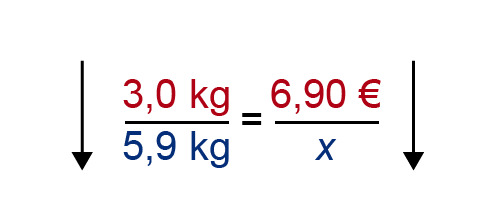19. Direct proportion
Direct proportionality
Proportionality can be used to solve various kinds of problems. However, before proportionality can be established between two quantities, it must be deduced whether the quantities are directly or inversely proportional with one another.
A person who works on an hourly wage knows that the more hours he or she works, the more money he or she will earn. Therefore, the salary and the number of hours worked increase in the same proportion. This is an example of direct proportionality. Direct proportionality also comes to the fore when shopping: the more things you buy, the more your total bill will be.
Quantities whose ratio remains constant are said to be directly proportional. This means that if one quantity doubles, the other also doubles. Conversely, if the second quantity decreases to a quarter, the other also decreases to a quarter.
Direct proportionality
If the quantities [[$ x $]] and [[$ y $]] are directly proportional, their number pairs [[$ (a, b) $]] and [[$ (c, d) $]] perform the following proportionality:
[[$$ \displaystyle\frac {b} {a} =\displaystyle\frac {d} {c} $$]]
This can also be written in a different form, as follows:
[[$$ \displaystyle\frac {b} {d} =\displaystyle\frac {a} {c} $$]]
When the dependence of directly proportional quantities is described in the coordinate system, the points will hit the same that passes through the origin. Because of this, directly proportional quantities are said to be linearly dependent on one another.
Example 1
Laura worked for 15 hours and was paid 90 QAR . Jenna, on the other hand, worked for 18 hours and was paid 108 QAR. Are working hours and pay directly proportional?
Solution:
Working hours and wages are directly proportional if the hourly wage remains constant for both Laura and Jenna.
[[$ \displaystyle\frac {90 \: \text {QAR}} {15 \: \text {h}} = 6 \displaystyle\frac { \: \text {QAR}} { \: \text {h}} $]] and [[$ \displaystyle\frac {108 \: \text {QAR}} {18 \: \text {h}} = 6 \displaystyle\frac { \: \text {QAR}} { \: \text {h}} $]].
This means that working hours and pay are directly proportional quantities.
Example 2
Three kilograms of mangoes costs 6,90 €. How much does five kilograms of mangoes cost?
Solution:
The equation can be used to form a comparison. Mark the asking price with [[$ x $]] and make an arrangement for the mass and price of the mangoes.

The upward trend in prices must be deduced. Logically, a larger amount of the same product costs more. Since the arrows are parallel, the quantities of mass and price are directly proportional with one another. The proportionality can be constructed as follows:

You can choose to put lower or higher values above the dividing lines, as long as you do the same on both sides of the equation. In other words, the direction of the arrows must remain the same on both sides of the equation.
By cross multiplying the equation, we arrive at a proportion equation that can be used to find out the price of the mangoes.
[[$ \quad \require{cancel} \begin{align} 3,0 \text{ kg} · x &= 5,0 \text{ kg} · 6,90 \text{ €} \space ||:3,0 \text{ kg} \ \\
x &= \dfrac{5,0 \cancel{\text{ k}} \text{g} · 6,90 \text{ €}}{3,0 \cancel{\text{ k}} \text{g}} \ \\
x &= 11,50 \text{ €} \end{align} $]]
Answer: 5,0 kg of mangoes costs 11,50 €.
Exercises
Basic exercises
Applied exercises
Challenging exercises
2/12. Submission folder for answers
Sinulla ei ole tarvittavia oikeuksia lähettää mitään.